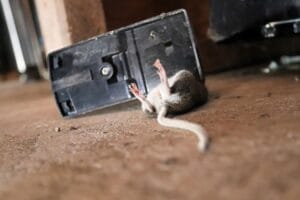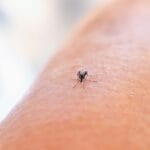Let’s dive straight into the heart of keeping our homes safe and secure from those pesky rodents. These creatures, while small, can cause significant headaches if they decide to take up residence in our abodes. But fear not, with the right knowledge and actions, we can fortify our homes and live rodent-free.
Key Takeaways
- Seal up entry points with materials like steel wool and caulk to keep rodents out.
- Store food in airtight containers and maintain a clean environment to deter rodents.
- Use traps strategically, placing them in high-traffic areas for rodents.
- Conduct regular inspections to identify and respond to signs of rodent activity quickly.
- When in doubt, professional pest control services can provide tailored solutions.
Understand What Attracts Rodents
Rodents are attracted to our homes for the same reasons we are: shelter, food, and water. These critters are looking for a cozy spot to nest, and if they can find a steady supply of crumbs or accessible food, they’ll think they’ve hit the jackpot. So, the first step in rodent-proofing your home is to eliminate these attractions:
- Keep food in sealed containers and never leave leftovers out.
- Fix leaky pipes and don’t leave water in sinks or buckets.
- Regularly dispose of garbage and keep bins sealed.
By cutting off their supply, you make your home far less appealing to rodents looking for a new place to settle.
Identify Common Entry Points
Next up, we need to play detective. Rodents can squeeze through the tiniest of gaps, so we’ll need to inspect our homes thoroughly. Common entry points include:
- Gaps in windows or doors
- Holes in exterior walls
- Openings around pipes or cables that enter the home
- Any cracks in the foundation or roofing
Once we know where they’re getting in, we can move on to fortifying these weak spots.
Entry Points: Your First Line of Defense
Sealing off entry points is crucial. You’ll want to arm yourself with some steel wool and caulk or some sturdy hardware cloth. These materials are excellent because rodents have a tough time chewing through them.
Doorways: Not Just for Guests

Doors should be inviting to friends and family, not rodents. Check the bottom of all your doors; if you can see light coming through, that’s a big enough gap for a mouse to squeeze through. Install door sweeps or thresholds to close these gaps, and consider weather stripping for a tighter seal.
Windows: Cracks and Screens
Windows are a favorite entry point for rodents, especially if they’re left open or if the screens have tears. Inspect all your window screens for damage and repair or replace them as needed. If you have cracks around the window frame, seal them up with caulk.
Vents and Chimneys: Sealing the Unseen
Vents and chimneys are often overlooked, but they’re like highways for rodents straight into your home. Cover these with metal mesh or specially designed vent covers that allow air to flow but keep rodents out.
- Ensure vent covers are secure and intact.
- Inspect the chimney for loose bricks and use a chimney cap.
Remember, a little preventative maintenance goes a long way in keeping these critters at bay. For more effective natural pest control strategies, explore our detailed guide.
Foundation and Exterior: Closing Gaps
The foundation of your home is its strength, but it can also be a vulnerable point for rodent entry. Walk around the exterior of your home and look for cracks or holes. Use concrete or mortar to fill in larger gaps, and apply caulk for smaller ones. It’s not just about being thorough; it’s about being proactive in pest-proofing your home.
Now, let’s talk about keeping the inside of your home as unattractive as possible to rodents.
Declutter and Organize Your Space
Clutter is not just an eyesore; it’s a haven for rodents. Piles of clothes, stacks of papers, and crowded garages give rodents plenty of places to hide. Take some time to declutter your home. Not only will it look and feel better, but you’ll also be removing potential nesting sites for rodents.
When organizing, use plastic storage bins with tight-fitting lids rather than cardboard boxes. Rodents can easily gnaw through cardboard, turning your stored items into their new home.
Trash Management: Secure Your Bins
Trash is like a buffet for rodents, offering a variety of scents and tastes. To keep rodents out of your garbage, always use bins with lids that close securely. If possible, keep your bins elevated off the ground and away from the walls of your home. This makes it harder for rodents to climb into the bins and discourages them from hanging around.
Traps and Baits: Our Allies Against Invaders
Even with the best prevention strategies, you may still find yourself with a rodent visitor. That’s where traps and baits come in. They’re essential tools in the pest control arsenal, but they must be used wisely to be effective and safe.
Choosing the Right Trap
- Snap traps: Simple and effective for mice and rats.
- Live traps: Capture rodents without harm, allowing for release far from your home.
- Glue traps: Useful in certain situations, but can be inhumane.
Place traps along walls or near suspected entry points, as rodents tend to travel along edges. Check and empty the traps regularly. If you’re using live traps, release the rodents several miles away from your home to prevent them from returning.
Remember, trapping is an ongoing process. It’s not just about catching the current invaders; it’s about being prepared for any future attempts at entry.
Most importantly, always handle traps with care and follow the manufacturer’s instructions. This ensures your safety and increases the effectiveness of the trap.
When using traps, always wear gloves to avoid leaving your scent and to protect yourself from potential diseases rodents may carry.
Safe Use of Baits and Poisons
Baits and poisons can be effective, but they come with risks. If you choose to use them, do so with caution.
Keep them out of reach of children and pets, and only use them according to the instructions. Remember that dead rodents can attract other pests, so continue to monitor the situation closely.
Maintenance and Monitoring: A Continuous Effort
Rodent proofing is not a one-and-done deal. It’s an ongoing commitment to maintaining your home and keeping it free from pests. Regular maintenance and vigilance are your best defenses against rodent infestations.

Stay alert to the signs of rodent activity: droppings, gnaw marks, and strange noises in the walls. At the first sign of trouble, take action. The quicker you respond, the easier it will be to control the situation.
Regular Inspections: What to Look For
Inspections are a key part of maintenance. Here’s what to look for:
Check for gaps or holes in the exterior of your home, especially where utilities enter. Look for droppings or signs of nesting in your garage, attic, or basement. Keep an eye on your garden and outdoor buildings for burrows or damage to plants that could indicate a rodent presence.
By staying on top of these inspections, you can catch potential issues before they become serious problems.
Keep a maintenance checklist and schedule regular walk-throughs of your property to ensure nothing goes unnoticed.
Responding to Signs of Rodent Activity
If you do find signs of rodents, take immediate action. Revisit your sealing efforts, check traps, and consider whether it’s time to call in professional pest control. The faster you respond, the less time rodents have to establish themselves and the easier it will be to remove them.
Wise Investments: Tools and Materials for Rodent Proofing
Investing in the right tools and materials can make all the difference in your rodent-proofing efforts. Here are some items you might consider:
Materials for Sealing Holes and Cracks
To effectively seal holes and cracks, you’ll need:
- Steel wool or copper mesh, which can be stuffed into gaps before sealing.
- High-quality caulk or foam sealant for smaller openings.
- Concrete or mortar for larger gaps in foundations or walls.
- Metal flashing to reinforce areas prone to gnawing.
Having these materials on hand means you can respond quickly to any new vulnerabilities.
Remember, the goal is to create a barrier that rodents can’t chew through or squeeze past. On the plus side, you’ll keep out other pests too, like Termites.
For larger repairs, you might need to consider hiring a professional to ensure the job is done right.
And for those hard-to-reach places or if you’re unsure about the best way to seal an opening, don’t hesitate to seek expert advice.
By following these strategies and tips, you can create a rodent-proof fortress that will keep your home safe and sound. Stay vigilant, stay prepared, and most importantly, don’t give up – a rodent-free home is well within your reach.
Professional Help: When to Call the Experts
Sometimes, despite our best efforts, the situation can get out of hand. Maybe you’ve noticed an increase in droppings or you’ve heard scurrying in the walls at night. Perhaps you’ve found a nest in your attic or, worse, electrical wires that have been chewed. These are signs that it’s time to call in the pest control professionals.

There’s no shame in admitting that an infestation is beyond your control. In fact, recognizing when you need help is crucial to protecting your home and health. Professionals have the tools, knowledge, and experience to effectively handle rodent problems, ensuring that the job is done safely and thoroughly.
Understanding When to Seek Professional Help
Seeking professional help should be considered when:
- You’ve tried traps and baits with no success.
- There is evidence of a large infestation, such as numerous droppings or widespread damage.
- There are signs of multiple species of rodents in your home.
It’s important to act quickly. Rodents reproduce rapidly, and a small problem can become a full-blown infestation in a matter of weeks.
Remember, professionals are trained to handle these situations and can provide peace of mind along with their expertise in pest control.
“If you’re waking up to the sound of little feet in the night, and you’ve found droppings or damage, it’s time to call the experts. Don’t wait until it’s too late; professional pest control can save you time, money, and a lot of headaches.”
What to Expect from Pest Control Services
When you hire pest control services, you can expect a thorough process that includes:
- An initial inspection to assess the extent of the infestation and identify entry points.
- A detailed plan of action tailored to your specific situation.
- Treatment using traps, baits, and possibly exclusion techniques to remove the rodents.
- Follow-up visits to ensure the problem is resolved and to prevent future infestations.
Pest control professionals are not only equipped to deal with current infestations, but they can also provide valuable advice on how to prevent future problems.
They may suggest improvements to your home’s defenses and offer maintenance tips to keep your home rodent-free long-term.
FAQ
It’s natural to have questions when it comes to rodent proofing your home. Here are some of the most common queries people have:
- What are the first signs of a rodent infestation?
- Can I rodent-proof my home on my own?
- How often should I inspect my home for rodent entry points?
- Are ultrasonic rodent repellents effective?
- What should I do if traditional traps don’t work?

Let’s tackle these one by one to give you a clearer understanding of what to do in each scenario.
What are the first signs of a rodent infestation?
The first signs include droppings, especially around food packages, under the sink, or in drawers and cupboards. You might also notice gnaw marks on food packaging or structures, a musky odor, or strange noises like scratching in the walls at night.
Can I rodent-proof my home on my own?
Yes, you can take many steps to rodent-proof your home yourself. Sealing entry points, maintaining a clean living space, and setting traps are all effective DIY measures. However, for larger infestations or ongoing issues, professional help might be necessary.
How often should I inspect my home for rodent entry points?
It’s a good idea to inspect your home for potential entry points at least twice a year. Seasonal changes can cause structures to expand and contract, potentially opening up new gaps for rodents to exploit. For more detailed guidance, consider reading about effective natural pest control and best practices to keep your home pest-free.
Are ultrasonic rodent repellents effective?
Ultrasonic rodent repellents can be a part of your rodent-proofing strategy, but they should not be relied upon as the sole method of control. Their effectiveness varies, and they are best used in conjunction with other preventative measures.
What should I do if traditional traps don’t work?
If traditional traps are not working, consider changing the bait or the type of trap you’re using. Rodents can become bait shy or learn to avoid certain traps. If you’re still not having success, it’s time to call in professional pest control services.
Remember, rodent proofing is about being proactive, diligent, and persistent. With the right approach, you can keep your home safe and rodent-free. Stay vigilant, and don’t hesitate to seek help if the problem is more than you can handle.








